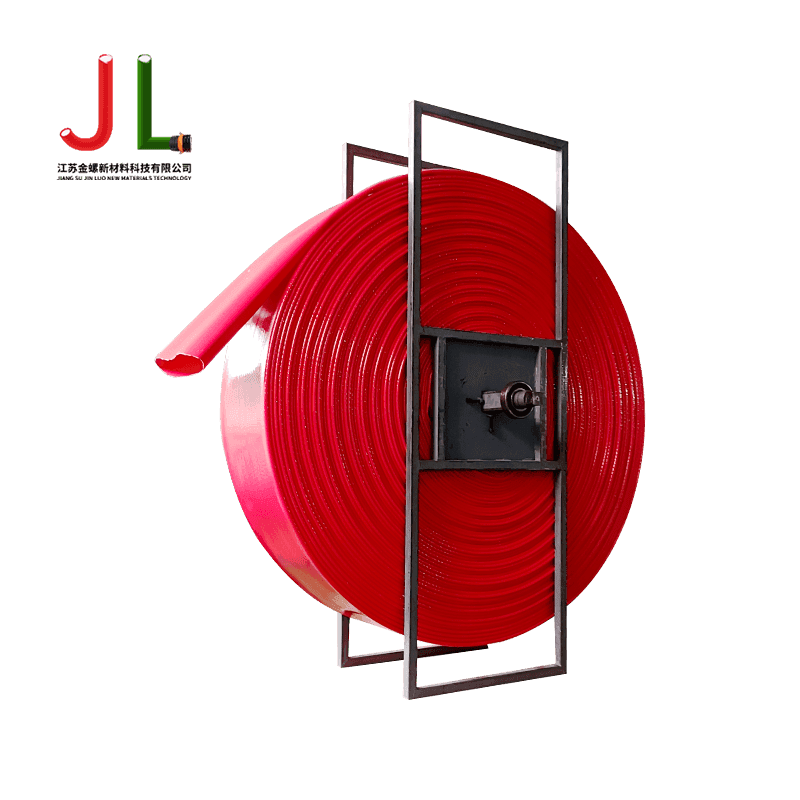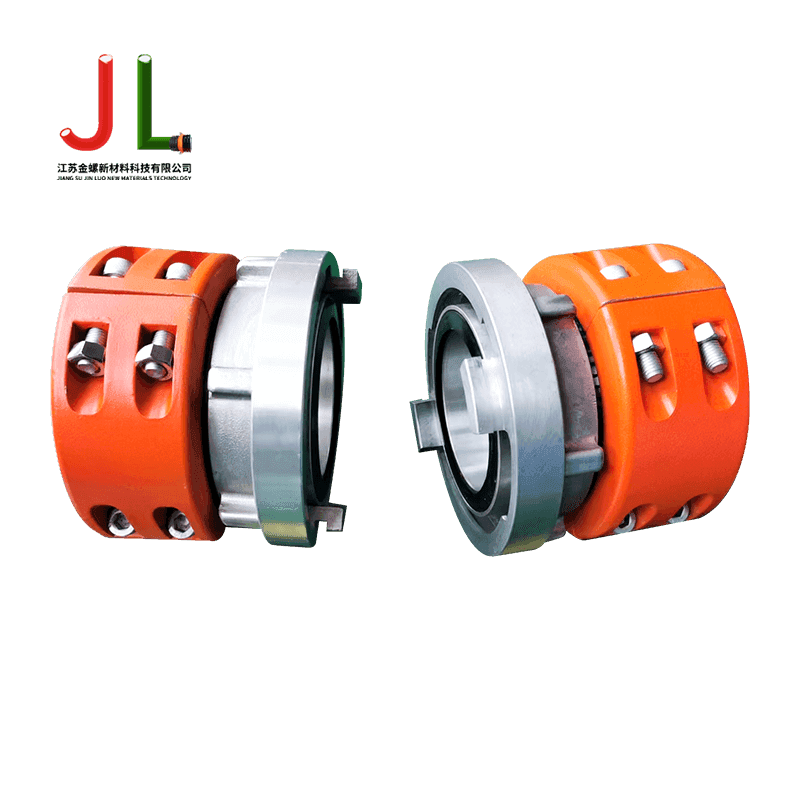1. What Are Discharge Hoses?
Discharge hoses are flexible tubes designed to transport liquids, semi-solids, or gases from one location to another under pressure. Unlike suction hoses (which pull material in), discharge hoses are built to withstand internal pressure, making them essential in industries where controlled flow and directional transfer are required.
Primary Functions of Discharge Hoses
- Material Transfer: Move water, chemicals, slurry, or abrasive solids.
- Pressure Handling: Designed to endure pumping forces without collapsing.
- Durability: Resistant to wear, kinking, and environmental factors.
Key Industries Using Discharge Hoses
| Industry |
Typical Use Case |
| Agriculture |
Irrigation, pesticide spraying, manure handling |
| Construction |
Dewatering, concrete pumping, slurry removal |
| Mining & Dredging |
Transporting gravel, sand, and wastewater |
| Chemical Processing |
Acid, solvent, or fuel transfer |
| Wastewater Treatment |
Effluent discharge, sludge removal |
Discharge Hose vs. Suction Hose: Key Differences
| Feature |
Discharge Hose |
Suction Hose |
| Pressure Resistance |
High (handles internal pressure) |
Low (collapses under vacuum) |
| Reinforcement |
Often wire- or fabric-reinforced |
May have spiral support to prevent collapse |
| Common Materials |
Rubber, PVC, thermoplastic |
Rubber, reinforced PVC |
| Typical Use |
Pumping out liquids/solids |
Drawing in liquids (e.g., from tanks) |
Basic Parameters to Identify Discharge Hoses
- Inner Diameter (ID): Ranges from ½ inch to 12+ inches, depending on flow needs.
- Pressure Rating: Measured in PSI/bar (e.g., 150 PSI for standard water transfer).
- Temperature Range: Some hoses handle -40°F to +200°F (-40°C to +93°C).
- Material Compatibility: Rubber (abrasion-resistant), PVC (lightweight), or specialty compounds (chemical-resistant).
Why Discharge Hoses Matter
Their ability to handle pressurized flow makes discharge hoses critical in preventing leaks, spills, and operational downtime. Selecting the right type ensures efficiency, safety, and longevity in demanding environments.
Types of Discharge Hoses
1. Rubber Discharge Hoses
- Construction: Reinforced with fabric or steel wire
- Pressure Range: 150-300 PSI
- Temperature Range: -40°F to +200°F (-40°C to +93°C)
- Best For: Abrasive materials, oil, and water applications
- Advantages: Excellent flexibility, kink-resistant, durable
2. PVC Discharge Hoses
- Construction: PVC material with spiral reinforcement
- Pressure Range: 100-250 PSI
- Temperature Range: 32°F to +140°F (0°C to +60°C)
- Best For: Lightweight water transfer, chemical applications
- Advantages: Lightweight, corrosion-resistant, affordable
3. Thermoplastic Discharge Hoses
- Construction: Multiple thermoplastic layers
- Pressure Range: 200-400 PSI
- Temperature Range: -60°F to +275°F (-51°C to +135°C)
- Best For: Chemical transfer, food-grade applications
- Advantages: Chemical-resistant, non-contaminating
4. Composite/Material-Specific Hoses
- Specialty Types:
- Chemical-resistant hoses (PTFE lining)
- Abrasion-resistant hoses (extra thick walls)
- Food-grade hoses (FDA-approved materials)
- Pressure Range: Varies by construction (150-600 PSI)
- Temperature Range: Varies by material
Applications of Discharge Hoses
| Industry |
Application |
Recommended Hose Type |
| Agriculture |
Pesticide spraying, irrigation |
PVC or chemical-resistant rubber |
| Construction |
Concrete pumping, dewatering |
Abrasion-resistant rubber |
| Mining |
Slurry transport, tailings removal |
Extra-heavy rubber with wire reinforcement |
| Chemical Processing |
Acid/alkali transfer |
PTFE-lined thermoplastic |
| Food Processing |
Liquid food transfer |
FDA-approved thermoplastic |
Discharge Hose Selection Guide
1. Material Compatibility Considerations
- Water: Standard rubber or PVC
- Oils/Fuels: Oil-resistant rubber compounds
- Acids/Alkalis: PTFE or specialty rubber
- Abrasive Slurries: Extra-thick rubber with wear-resistant lining
2. Size and Flow Requirements
- Diameter Selection Guide:
- 1-2" for low-volume applications
- 3-6" for moderate flow
- 8"+ for high-volume transfer
- Flow Rate: Match hose size to pump capacity
3. Pressure and Temperature Factors
- Working Pressure: Always exceed system pressure by 25%
- Burst Pressure: Minimum 4x working pressure
- Temperature: Verify hose rating matches fluid temperature
4. Reinforcement Needs
- Standard Duty: Single fabric layer (150 PSI)
- Heavy Duty: Multiple fabric layers (300 PSI)
- Extra Heavy Duty: Steel wire reinforcement (400+ PSI)
5. Flexibility vs. Rigidity
- High Flexibility: Required for moving equipment
- Stiffer Hoses: Better for high-pressure applications
6. End Connections
- Common Types:
- Camlock fittings
- NPT threaded ends
- Flange connections
- Selection Tip: Match to existing equipment fittings
Performance Comparison Table
| Feature |
Rubber Hoses |
PVC Hoses |
Thermoplastic Hoses |
| Max Pressure |
300 PSI |
250 PSI |
400 PSI |
| Temperature Range |
-40°F to +200°F |
32°F to +140°F |
-60°F to +275°F |
| Chemical Resistance |
Moderate |
Good |
Excellent |
| Abrasion Resistance |
Excellent |
Good |
Moderate |
| Flexibility |
Very Good |
Good |
Fair |
| Weight |
Heavy |
Light |
Medium |
| Lifespan |
3-5 years |
2-4 years |
5-7 years |
Special Considerations
- Static Conductivity: Required for flammable liquids
- UV Resistance: Important for outdoor use
- Bend Radius: Minimum curvature before flow restriction
- Regulatory Compliance: NSF, FDA, or other industry standards
3. Key Features of High-Quality Discharge Hoses
1. Pressure Performance Specifications
- Working Pressure Rating:
- Standard duty: 150-250 PSI
- Heavy duty: 250-400 PSI
- Industrial grade: 400-600+ PSI
- Burst Pressure Safety Margin:
- Minimum 4:1 safety ratio (burst pressure vs working pressure)
- Example: 300 PSI hose should have 1200+ PSI burst rating
2. Material Durability Factors
| Material Property |
Importance |
Testing Standard |
| Abrasion Resistance |
Critical for slurry/solids |
ASTM D3389 |
| Chemical Resistance |
Prevents degradation |
ASTM D543 |
| UV/Ozone Resistance |
Outdoor longevity |
ASTM D1149 |
| Tensile Strength |
Prevents rupture |
ASTM D412 |
3. Reinforcement Construction
- Standard Reinforcements:
- Single textile ply (150-200 PSI)
- Dual textile plies (200-300 PSI)
- Steel wire helix (300-600+ PSI)
- Reinforcement Comparison:
- Fabric: Better flexibility, lower weight
- Wire: Higher pressure capacity, kink resistance
4. Temperature Tolerance Ranges
| Hose Type |
Minimum Temp |
Maximum Temp |
| Standard Rubber |
-40°F (-40°C) |
200°F (93°C) |
| Specialty Rubber |
-65°F (-54°C) |
250°F (121°C) |
| PVC |
32°F (0°C) |
140°F (60°C) |
| Thermoplastic |
-60°F (-51°C) |
275°F (135°C) |
5. Flow Efficiency Characteristics
- Smooth Bore Design:
- Minimum friction loss (measured in PSI drop per 100ft)
- Typical values: 2-5 PSI drop at rated flow
- Inner Diameter Consistency:
- Tolerance: ±3% of nominal size
- Prevents flow restriction at bends
6. Safety Certifications
- Critical Certifications:
- NSF/ANSI 61 for potable water
- FDA 21 CFR for food contact
- ATEX for explosive environments
- UL listing for fire resistance
7. Physical Properties Comparison
| Property |
Economy Grade |
Industrial Grade |
Premium Grade |
| Pressure Rating |
150 PSI |
300 PSI |
500+ PSI |
| Bend Radius |
10x diameter |
8x diameter |
5x diameter |
| Weight (per ft) |
Heavy |
Moderate |
Lightweight |
| Service Life |
1-2 years |
3-5 years |
5-8 years |
| Kink Resistance |
Poor |
Good |
Excellent |
8. Special Performance Features
- Static Dissipative: Surface resistivity <10^5 ohms (for flammable liquids)
- Anti-Microbial: For food/pharmaceutical applications
- Non-Marking: Important for cleanroom environments
- Floatation Capability: Foam core for marine applications
9. Endurance Testing Standards
- Flex Cycle Rating: Minimum 50,000 cycles (ASTM D380)
- Impulse Testing: 100,000+ pressure cycles (SAE J343)
- Abrasion Testing: Minimum 500 cycles (ISO 6945)
4. Maintenance and Safety Tips for Discharge Hoses
1. Proper Storage Guidelines
- Ideal Storage Conditions:
- Temperature: 32°F to 100°F (0°C to 38°C)
- Humidity: Below 65% RH
- Avoid direct sunlight exposure (UV degradation)
- Storage Position:
- Lay flat or hang vertically
- Never store with kinks or sharp bends
- Minimum bend radius: 10x hose diameter
2. Routine Inspection Checklist
| Inspection Point |
Acceptable Condition |
Replacement Criteria |
| Outer Cover |
No cracks/abrasions |
Visible cracks >10% circumference |
| Reinforcement |
No exposed wires |
Any wire protrusion |
| Fittings |
No corrosion/seepage |
Visible leaks under pressure |
| Flexibility |
Normal bend radius |
Stiffness >20% increase |
| Internal Surface |
Smooth bore |
Visible pitting/erosion |
3. Cleaning Procedures by Application
- Water/Wastewater: Flush with clean water at 1.5x working pressure
- Chemical Transfer: Triple rinse with compatible solvent
- Oil/Fuel: Purge with detergent solution (pH 7-9)
- Slurry/Solids: Mechanical brushing + air blast cleaning
4. Pressure Testing Protocol
- Frequency: Quarterly for continuous use
- Test Method: Hydrostatic test at 1.5x working pressure
- Duration: 30 minutes minimum
- Acceptance Criteria: <2% pressure drop, no visible leaks
5. Safety Handling Parameters
| Hazard Type |
Prevention Measure |
Emergency Response |
| Chemical Exposure |
Compatible material selection |
Immediate flush (15 mins) |
| Pressure Failure |
Regular burst testing |
Isolate and depressurize |
| Abrasion Damage |
Proper routing/support |
Shutdown and inspect |
| Thermal Stress |
Monitor fluid temperature |
Cool before handling |
6. Operational Best Practices
- Installation:
- Maintain minimum 5x diameter bend radius
- Use proper supports every 3-5 feet
- Operation:
- Avoid sudden pressure surges (>10% PSI/sec)
- Maximum flow velocity: 20 ft/sec for liquids
- Shutdown:
- Gradual pressure reduction
- Complete drainage before storage
7. Special Considerations for Jiangsu Jinluo Products
Given Jiangsu Jinluo New Material Technology Co., Ltd's specialization in polyurethane and industrial hoses (2-16 inch diameters), note these specific maintenance aspects:
- Polyurethane Hoses:
- Enhanced chemical resistance but avoid strong acids
- Superior abrasion resistance (50% better than standard rubber)
- Storage life: 5 years (unused in proper conditions)
- Large Diameter Hoses (8-16 inch):
- Require specialized cleaning equipment
- Need reinforced support structures
- Inspection frequency: Monthly for continuous use
8. Life Extension Techniques
- Rotation System: Alternate multiple hoses in heavy-use applications
- Protective Sleeving: Add abrasion guards at contact points
- End Fitting Maintenance: Annual thread lubrication/inspection
- Pressure Cycling: Gradually increase/decrease pressure
9. Disposal and Recycling
- End-of-Life Signs:
- Crack propagation >30% length
- Pressure rating drop >25%
- Permanent deformation >5% diameter
- Environmental Compliance:
- Separate by material type (rubber/PVC/TPU)
- Follow local regulations for industrial hose disposal
Jinluo Heavy-Duty Polyurethane Pressure Hose - Flexible Reinforced TPU Flat Tubing




 English
English عربى
عربى 中文
中文













